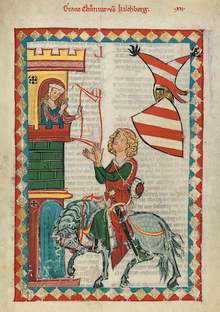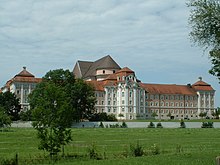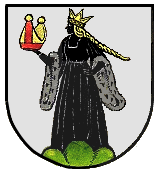Counts of Kirchberg (Swabia)

The Counts of Kirchberg were a Swabian noble family who were especially wealthy south of Ulm , on the right and left of the Iller . They are difficult to document in a document, but in the late early Middle Ages and in the early high Middle Ages they had a significance that went beyond regional power. By the end of the 12th century, the family split into two lines, and a little later into three lines, became increasingly impoverished towards the end of the Middle Ages and went out in 1510 after their possessions and rights were sold.
The ancestral seat of the Kirchbergers was probably in Unterkirchberg, in today's municipality of Illerkirchberg . Towards the end of the 11th century it was moved up the Iller to the Oberkirchberg, where a hilltop castle was built, where the Fugger Castle now stands. The poorly interpreted coat of arms of the Kirchbergers shows a woman (later often a Mohrin) who holds a helmet or a lily in her hands, later a miter .
origin
The origin of the Kirchbergers and their early genealogy cannot be historically taken seriously. The frequent use of the first names Otto and Hartmann could indicate family relationships with the Counts of Buchhorn, a branch of the Udalrich family who were wealthy on Lake Constance and already extinct in 1089 , or with the Hupaldingers . A Hartmann is mentioned in 980 as Gaugraf im Illergau . It was first mentioned in a document in 1087, when an Otto de Chirchperg attested to a donation to the Salvator Monastery in Schaffhausen . The foundation and rich equipment of the Benectin Abbey of St. Martin in Wiblingen in 1093 by the brothers Otto and Hartmann von Kirchberg shows the financial possibilities of the Kirchbergers at that time. The Wiblingen monastery remained the burial place of this noble family until the Kirchbergers died out .
coat of arms
The first heraldic evidence of the Kirchbergers is a seal around 1200 showing three roofed towers. It is preserved in a reduced form in the coat of arms of the city of Bruneck . It was not until the middle of the 13th century that other image sources exist that always show a crowned female figure wearing either a helmet or a lily in her hands. The heraldic statement of this figure has not been clarified. Lily or helmet were replaced by a miter from the late 13th century, which is probably due to the bishop of Brixen , Bruno von Kirchberg . In the late Middle Ages, the female figure was often depicted as a Moor. In this form, they also added the Fuggers , who bought the county in 1507, to their coat of arms. The current coats of arms of Illerkirchberg and Oberkirchberg also go back to the late medieval coats of arms of the Kirchbergers.
Dominion
The county of Kirchberg was an imperial fiefdom that arose from the eastern parts of the former Rammachgau . The area can be described as an irregular quadrangle, the northern border of which was formed by the Danube from the confluence of the Roth upstream to around Obermarchtal , the eastern border was originally probably the Roth , later the Iller and the western border the Riss and the upper reaches of the Schussen . The cornerstones of the irregular southern border are Boos in the southeast, the lower reaches of the Aitrach in the south and the area south of Schussenried in the southwest. In this area, the Kirchbergers had the count's rights of rule, enjoyed the corresponding rights of use and were protected from wild animals . Their allodial possessions were concentrated between Rot and Roth, but were also partly north of the Danube and east of the Roth. Parts of it went to the local lower nobility and citizens of Ulm as after- fiefs or fiefs in the High and Late Middle Ages .
History of the Kirchbergers in the High and Late Middle Ages
In the High Middle Ages, probably still in the 12th century, the Kirchbergers split into two, and in 1250 into three lines. The reasons for the first division cannot be established in a document.
- Kirchberg-Kirchberg: The main line kept its headquarters on Oberkirchberg and the count's rights. Count Wilhelm died in 1366. His daughter Agnes had been married to Ulrich von Matsch since 1346 and brought her inheritance into this marriage. With this, parts of the original Kirchberg property went to this powerful noble family, rich in Vinschgau , Engadin , Veltlin and in Graubünden , who soon bought the remaining part, the dowry from Count Wilhelm's sister Bertha. As a result, the Matscher temporarily held the additional title of Count von Kirchberg.
- Kirchberg-Brandenburg: The rule of the Kirchberg-Brandenburg follows to the southwest. Their center of power was in Dietenheim , which received town charter as early as 1280. From their ancestral castle (probably Regglisweiler Castle ) only overbuilt trenches are preserved. The Brandenburgers seem to have been the most politically active line; representatives of this family appear several times on royal documents. The first documentary evidence of a (Kirchberg) Brandenburger (Count Otto) dates to February 2nd, 1239. According to the chronicle of the Reichsabtei Rot (Roth) on the Rot, the split of the line could be even earlier. After the severe wound of Count Hartmann VI. of Brandenburg in the battle of Oberndorf (April 17, 1298), this is mentioned for the last time on April 30, 1298 when it was handed over to the Heggbach monastery. As a result, the Brandenburg estates were confiscated by King Albrecht I and, regardless of the inheritance claims of the Kirchbergers who were still alive, were loaned to the Ellerbach family, who were loyal to the Habsburg castle . The last Brandenburg citizen was Abbot Konrad V of the Allerheiligen / Schaffhausen monastery, who died on March 12, 1322 (1323).
- Kirchberg-Wullenstetten: This line was created in 1250 from an inheritance that the Kirchberg brothers Conrad II and Eberhard III. carried out. Eberhard was the founder of the Wullenstetter line. His possessions were mainly to the right of the Iller. On January 25, 1322, Eberhard's son, Count Konrad the Elder, is named with his seat in Wullenstetten. It is possible that after the loss of the Kirchberg family estates, the Wullenstetter became the administrators of the Freiherrn von Matsch and resided in the family castle on the Oberkirchberg. Kirchberg-Wullenstetten was able to get the old Kirchberg possessions back as a pledge in 1390; In 1434, Eberhard von Kirchberg-Wullenstetten was enfeoffed again with the county by King Sigismund , so that large parts of the Kirchberg family property came back into the hands of the family.
The end of the Kirchbergers
The last representatives of the count family were the two cousins Wilhelm (died around 1489) and Philipp from the Wullenstetten line, who shared the inheritance. Both were heavily in debt. Wilhelm, who was apparently the personal servant of Count Eberhard V. von Württemberg-Urach from 1473 , sold his half in 1481 to Duke Georg von Bayern-Landshut , Philipp in 1498. Duke Georg was already in the possession of the neighboring lords of Weißenhorn and Pfaffenhofen to the east . After George's death in December 1503 and the beginning of the Landshut War of Succession , King Maximilian I seized the rulers and pledged them in 1507 for the very large sum of 50,000 guilders to the Fuggers , who after their elevation to the hereditary imperial rank (1526), Counts of Kirchberg and Weißenhorn named. Philipp remained administrator of the Kirchberg estates until his death on August 20, 1510. His daughter and heir Appolonia and her husband, Count Hans von Montfort - Tettnang, sell the Wain estate he had acquired in 1499 in November 1510 (Saturday before Martini).
Important Kirchbergers
- Konrad von Kirchberg: Konrad is depicted on the miniature 24r of the Great Heidelberg song manuscript as a knight ( Graue Chunrat vo Kilchberg ) who, on horseback, presents a poem to his beloved. There are 22 stanzas that have survived, divided into three summer and three winter songs, which are reminiscent of Neidhart and Tannhäuser in terms of motif and form . The historical person is uncertain; it is either Konrad (documented between 1255 and 1268) or his son of the same name (documented between 1286 and 1315).
- Bruno von Kirchberg (Brixen): Bruno's father was most likely Count Konrad (I.) von Kirchberg. The tradition from Brixen is likely to be correct, since Bruno's brothers Konrad II and Eberhard III. von Kirchberg called their firstborn Konrad. His mother was named Bertha after the necrologists from Stams and Brixen. She comes from the family of the Counts of Gorizia. It could be the daughter of Engelbert III named in the Gurk historical sources in 1206 (Strasbourg / Carinthia). be about Gorizia and Mathilde von Andechs. Mathilde's sister was also called Bertha (Abbess von Gerbstett). That would make Bruno's mother a sister of Count Meinhard III. von Görz, who called himself Meinhard I. von Tirol und Görz (III.) from 1252. Presumably through this connection with the Görzern, Bruno came to the cathedral school in Brixen as a child on the occasion of a deed in Lyon (July 5, 1274). He thanks for the education there. Bruno was originally intended for the office of bishop in Trento , which he had to do without after papal intervention. From 1250 until his death on August 24, 1288 he was Bishop of Brixen. The founding of the city of Bruneck and the construction or expansion of the Bruneck Castle go back to him. The name of the city is variously derived from his first name. He is also a co-founder of the Cistercian Abbey of Stams in the Inn Valley .
- Ida von Toggenburg (saint) : Ida (* approx. 1156, † approx. 1226) or Idda , as it is mostly written in Switzerland , comes from the Kirchberg family, according to legend. Married to a Count of Toggenburg , she spent many years as an inclusive in Au and at Fischingen Abbey . Cult places are the Idda chapel in the Fischingen monastery and the St. Iddaburg at the former headquarters of the Toggenburgers.
literature
- Wilhelm Werner von Zimmer : Genealogy of the Counts of Kirchberg , manuscript, Württembergische Landesbibliothek Stuttgart, Cod.Donaueschingen 593a ( digitized )
- Sarah Hadry: Kirchberg, Count of. In: Historical Lexicon of Bavaria. (on-line)
- Sarah Hadry, article group "Kirchberg, Grafen von", in: Residency Commission of the Academy of Sciences in Göttingen (ed.), Dynastisch-topographisches Handbuch. Volume 4: Counts and Lords in the Late Medieval Empire, Kiel 2012, 757–769.
- Sarah Hadry, Neu-Ulm. The Altlandkreis (Historical Atlas of Bavaria, Swabia I / 18), Munich 2011.
- Rudolf Vierhaus (ed.): German biographical encyclopedia. Volume?, 2nd edition. KG Saur Verlag, Munich 2006, ISBN 3-598-25030-4 .
- Franz Huter: Brun. In: New German Biography (NDB). Volume 2, Duncker & Humblot, Berlin 1955, ISBN 3-428-00183-4 , p. 669 f. ( Digitized version ).
- Philipp Jedelhauser: The descent of Bishop Bruno von Brixen, Count of Kirchberg (Iller) with an excursus on Countess Mathilde von Andechs, wife of Count Engelbert III. von Görz and family table of the Counts of Görz, in: Adler, Zeitschrift für Genealogie und Heraldik, Volume 28, Issue 6–7, Vienna April / September 2016, pp. 277–341, see pp. 278–303, on Counts of Kirchberg v. a. Note 96-109. Also available as a book, 2nd revised edition 1217, ISBN 978-3-00-0524899 .
Web links
Individual evidence
- ↑ Note: The main and almost exclusive source for this article is this article by Sarah Hadry. References to individual passages in the text have not been made in this article, as this entry is essentially only a condensed excerpt from the source mentioned.
- ↑ Armin Schlechter and Gerhard Stamm (eds.): The manuscripts of the Badische Landesbibliothek in Karlsruhe . The small provenances . Vol. 13; Harrassowitz Wiesbaden 2000. ISBN 3-447-04373-3 ; P. 222
- ↑ Sarah Hadry: Kirchberg-Weißenhorn, Herrschaft. In: Historical Lexicon of Bavaria. (on-line)
- ↑ a b R. Vierhaus (ed.): German biographical encyclopedia. Volume?, 2006, p. 861.
- ^ Bruneck, History of Tyrol
- ^ Franz Huter: Brun. In: New German Biography (NDB). Volume 2, Duncker & Humblot, Berlin 1955, ISBN 3-428-00183-4 , p. 669 f. ( Digitized version ).
- ↑ Idda. In: Saints of Switzerland. Retrieved July 24, 2019 .


